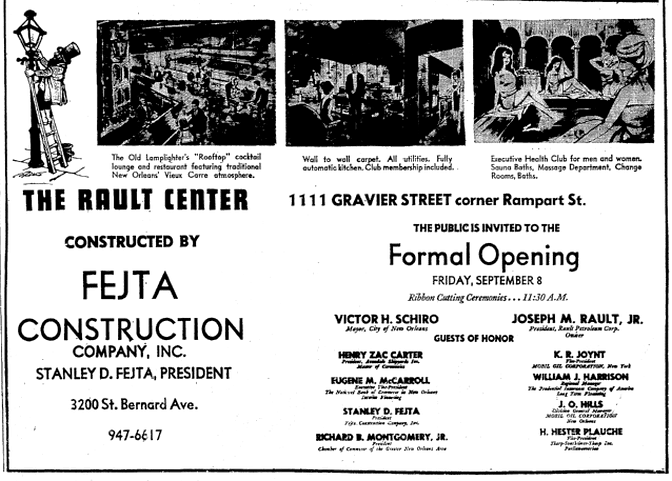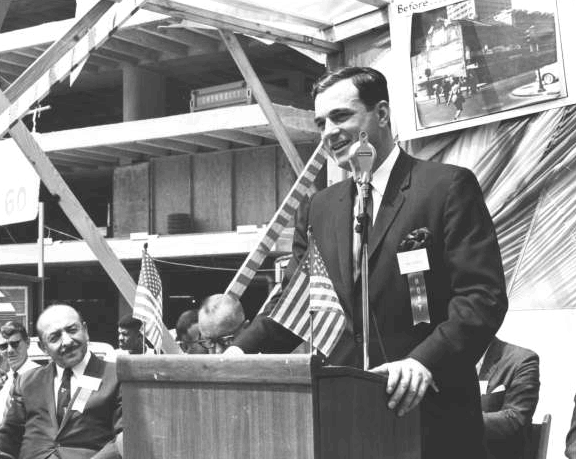|
Today in New Orleans History |
|
|
November 29


New
Orleans born Joseph M. Rault developed apartment complexes and land use in Louisiana and Mississippi. He entered the Navy
after graduating from Jesuit in 1943, and was the commander of the USS LCI-549 and participated in the atomic bomb test
at the Bikini Atoll. In 1946, he entered MIT and graduated with a Bachelor's Degree in Marine Transportation in 1948. In
1955 he graduated from Tulane Law School and practiced Admiralty in Maritime Law until 1960 with the Terriberry Firm.
He then opened his own company building offshore vessels and semi-submersible drilling rigs. He merged one of these companies
with John Laborde to create Tidewater Marine and contracted with PeMex to drill a number of wells in Mexico and import oil
from Venezuela. He and his wife, Bonnie reside in Metairie.
     As of September 2013 Drew Brees holds the record for consecutive games with at least one touchdown
pass which stands at 54. He set the record on October 7, 2012 when he surpassed the streak of 47 consecutive
games by Johnny Unitas which had stood since December 11, 1960. Unitas had held the record for nearly 52 years when
he surpassed Cecil Isbell's streak of 23 which had been established as the record in 1942. Brees record streak of 54 games
ended on November 29, 2012 against the Atlanta Falcons. Brees also holds the record for consecutive
uninterrupted games with a touchdown pass including playoffs with 49, surpassing Brett Favre's record of 39. Tom Brady holds
the record for most consecutive regular season uninterrupted games with at least one touchdown pass with 50, setting the
record on December 2, 2012, surpassing Brees' 43. Both players had surpassed Favre's record of 36, set
in 2004.
Dixieland jazz pianist, clarinetist, and drummer Ollie "Dink"
Johnson (October 28, 1892 – November 29, 1954)
was a was born in Biloxi, the younger brother of the bass player/bandleader
William Manuel Johnson. He worked around Mississippi and New Orleans before moving out west
in the early 1910s. He played in Nevada and California, often with his brother Bill. Most prominently he played with the Original Creole Orchestra (mostly on drums). He also played clarinet in Kid Ory's band. For many years
he was based in Los Angeles where he led a band in the 1920s and later ran a bar called
Dink's Place at 4429 Avalon Blvd. He was visited there in March 1946 by Bill Russell, who organised most of his piano and
one man band recordings. Russell wrote in his diary that Dink had a room at the back for selling bootleg whisky, and kept
a gun in a saucepan "because the police would never look there". He told Russell that he had "always lived
outside the law." He made his first recordings in 1922 on clarinet with Kid Ory's Band. He made more recordings in the
1940s and 1950s, mostly on piano, although also doing some one-man band recordings, playing all three of his instruments through
over dubbing. Johnson's piano style was influenced by Jelly Roll Morton (his brother-in-law); his clarinet playing by
Larry Shields. Johnson also wrote tunes, including "The Krooked Blues" (recorded by King Oliver) and "So
Different Blues" . (From wikipedia)
The November 29, 1909 edition of the New York Times reported the final reports on the cotton
crop of 1909 as 10625000 bales.
A transfer ceremony for the Louisiana Purchase was held in New Orleans on November 29, 1803.
Since the Louisiana territory had never officially been turned over to the French, the Spanish took down their flag, and
the French raised theirs. On November 30, General James Wilkinson accepted possession of
New Orleans for the United States. A similar ceremony was held in St. Louis on March
9, 1804, when a French tricolor was raised near the river, replacing the Spanish national flag. The following day,
Captain Amos Stoddard of the First U.S. Artillery marched his troops into town and had the
American flag run up the fort's flagpole. The Louisiana territory was officially transferred to the United States government,
represented by Meriwether Lewis. The Louisiana Territory, purchased for less than 3 cents an acre, doubled the size of the
United States overnight, without a war or the loss of a single American life, and set a precedent for the purchase of territory.
It opened the way for the eventual expansion of the United States across the continent to the Pacific. |
|
|

To receive an update for each day in New Orleans history,
join our facebook page - Today in New
Orleans History.
Analytics |


 The top three stories were occupied by the Roof Top Club, a members-only women and mens club featuring Old Lamplighter's rooftop
cocktail lounge, a roof-top pool and sun-deck, a putting green, a spa for women, and a health club for men.
The top three stories were occupied by the Roof Top Club, a members-only women and mens club featuring Old Lamplighter's rooftop
cocktail lounge, a roof-top pool and sun-deck, a putting green, a spa for women, and a health club for men. 

